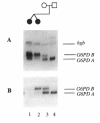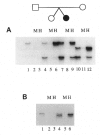Abstract
Rett syndrome (RS), a progressive encephalopathy with onset in infancy, has been attributed to an X-linked mutation, mainly on the basis of its occurrence almost exclusively in females and its concordance in female MZ twins. The underlying mechanisms proposed are an X-linked dominant mutation with male lethality, uniparental disomy of the X chromosome, and/or some disturbance in the process of X inactivation leading to unequal distributions of cells expressing maternal or paternal alleles (referred to as a "nonrandom" or "skewed" pattern of X inactivation). To determine if the X chromosome is in fact involved in RS, we studied a group of affected females including three pairs of MZ twins, two concordant for RS and one uniquely discordant for RS. Analysis of X-inactivation patterns confirms the frequent nonrandom X inactivation previously observed in MZ twins but indicates that this is independent of RS. Analysis of 29 RS females reveals not one instance of uniparental X disomy, extending the observations previously reported. Therefore, our findings contribute no support for the hypothesis that RS is an X-linked disorder. Furthermore, the concordant phenotype in most MZ female twins with RS, which has not been observed in female twins with known X-linked mutations, argues against an X mutation.
Full text
PDF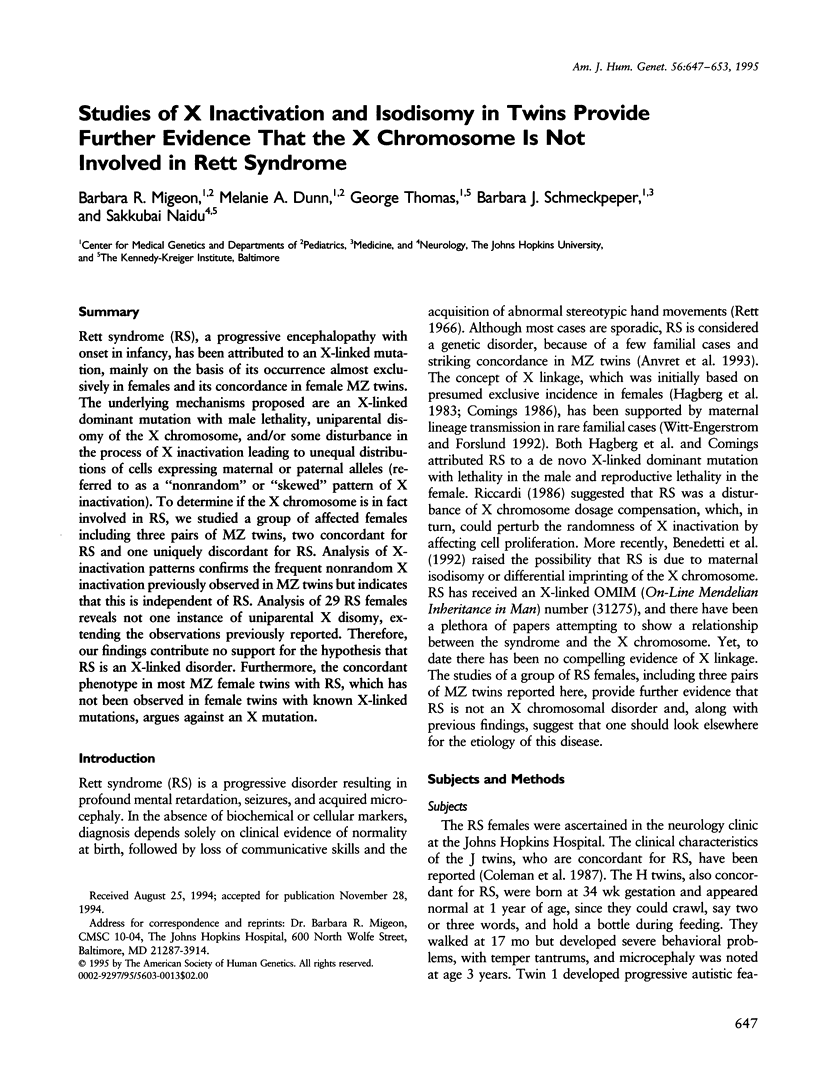



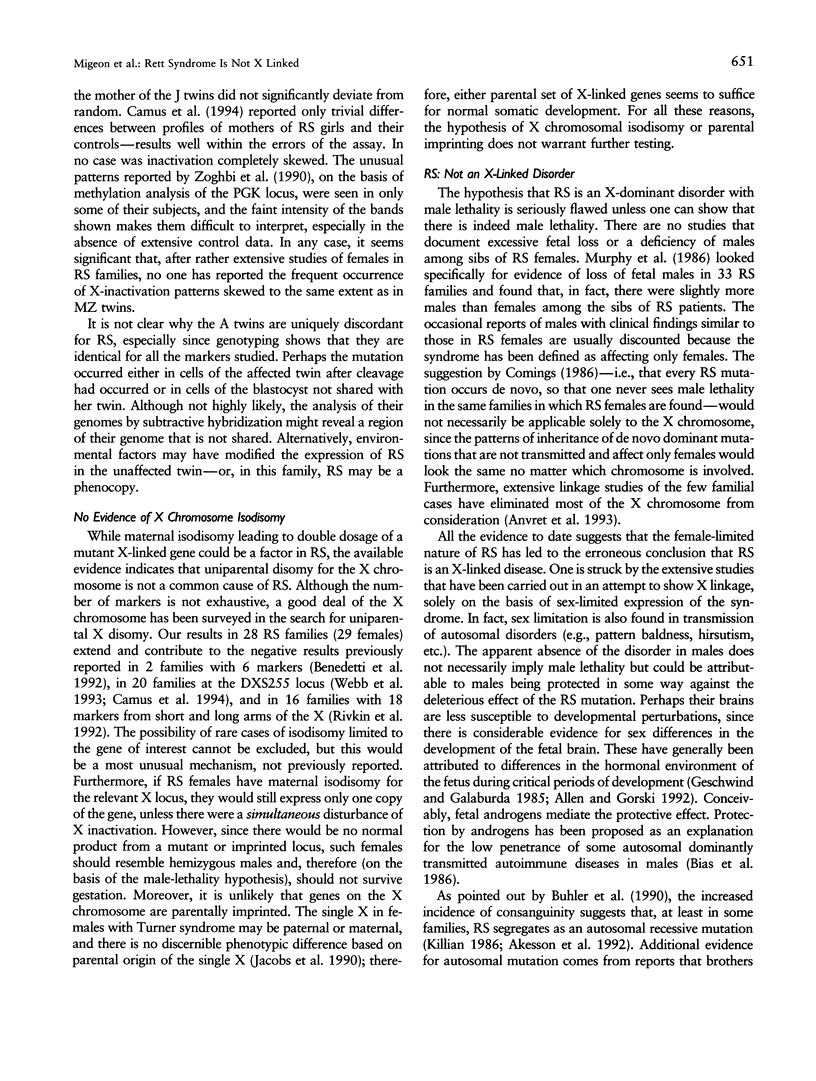

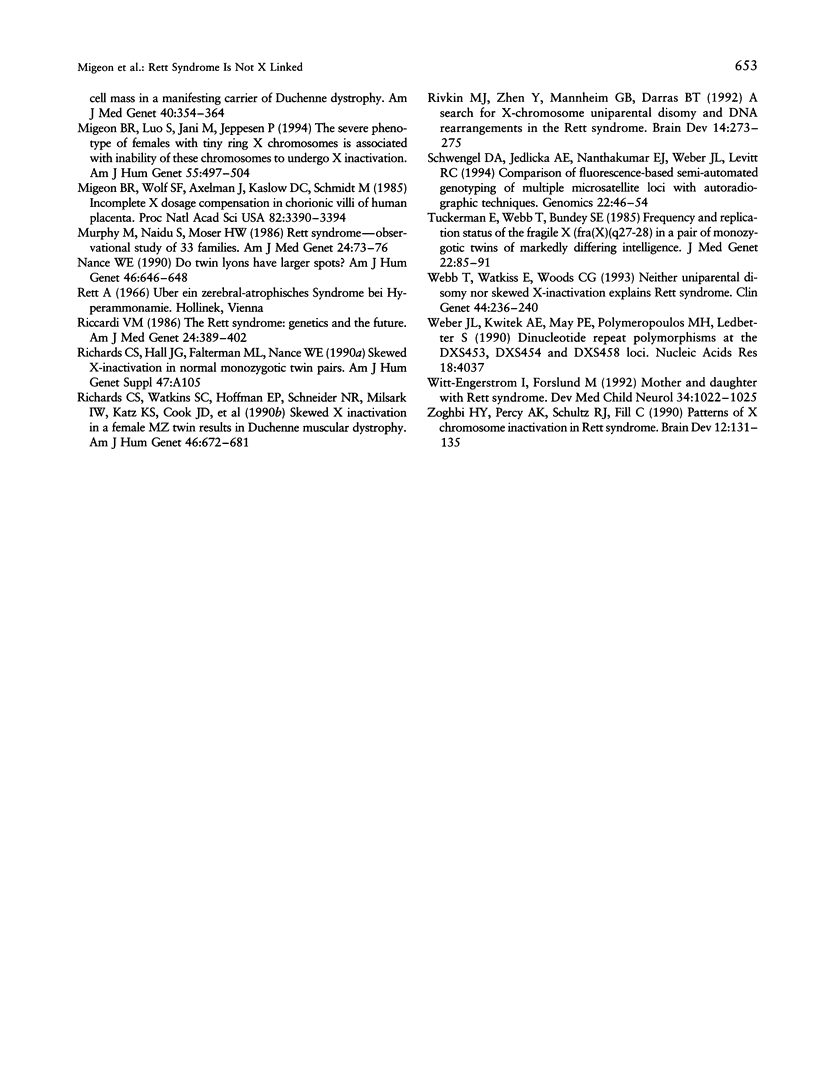
Images in this article
Selected References
These references are in PubMed. This may not be the complete list of references from this article.
- Akesson H. O., Hagberg B., Wahlström J., Engerström I. W. Rett syndrome: a search for gene sources. Am J Med Genet. 1992 Jan 1;42(1):104–108. doi: 10.1002/ajmg.1320420121. [DOI] [PubMed] [Google Scholar]
- Allen L. S., Gorski R. A. Sexual orientation and the size of the anterior commissure in the human brain. Proc Natl Acad Sci U S A. 1992 Aug 1;89(15):7199–7202. doi: 10.1073/pnas.89.15.7199. [DOI] [PMC free article] [PubMed] [Google Scholar]
- Allen R. C., Zoghbi H. Y., Moseley A. B., Rosenblatt H. M., Belmont J. W. Methylation of HpaII and HhaI sites near the polymorphic CAG repeat in the human androgen-receptor gene correlates with X chromosome inactivation. Am J Hum Genet. 1992 Dec;51(6):1229–1239. [PMC free article] [PubMed] [Google Scholar]
- Anvret M., Wahlström J. Rett syndrome: random X chromosome inactivation. Clin Genet. 1994 May;45(5):274–275. doi: 10.1111/j.1399-0004.1994.tb04157.x. [DOI] [PubMed] [Google Scholar]
- Benedetti L., Munnich A., Melki J., Tardieu M., Turleau C. Parental origin of the X chromosomes in Rett syndrome. Am J Med Genet. 1992 Sep 1;44(1):121–123. doi: 10.1002/ajmg.1320440131. [DOI] [PubMed] [Google Scholar]
- Bias W. B., Reveille J. D., Beaty T. H., Meyers D. A., Arnett F. C. Evidence that autoimmunity in man is a Mendelian dominant trait. Am J Hum Genet. 1986 Nov;39(5):584–602. [PMC free article] [PubMed] [Google Scholar]
- Burn J., Povey S., Boyd Y., Munro E. A., West L., Harper K., Thomas D. Duchenne muscular dystrophy in one of monozygotic twin girls. J Med Genet. 1986 Dec;23(6):494–500. doi: 10.1136/jmg.23.6.494. [DOI] [PMC free article] [PubMed] [Google Scholar]
- Bühler E. M., Malik N. J., Alkan M. Another model for the inheritance of Rett syndrome. Am J Med Genet. 1990 May;36(1):126–131. doi: 10.1002/ajmg.1320360125. [DOI] [PubMed] [Google Scholar]
- Camus P., Abbadi N., Gilgenkrantz S. X inactivation in Rett syndrome: a preliminary study showing partial preferential inactivation of paternal X with the M27 beta probe. Am J Med Genet. 1994 Apr 15;50(3):307–308. doi: 10.1002/ajmg.1320500321. [DOI] [PubMed] [Google Scholar]
- Clemens P. R., Fenwick R. G., Chamberlain J. S., Gibbs R. A., de Andrade M., Chakraborty R., Caskey C. T. Carrier detection and prenatal diagnosis in Duchenne and Becker muscular dystrophy families, using dinucleotide repeat polymorphisms. Am J Hum Genet. 1991 Nov;49(5):951–960. [PMC free article] [PubMed] [Google Scholar]
- Coleman M., Naidu S., Murphy M., Pines M., Bias W. A set of monozygotic twins with Rett syndrome. Brain Dev. 1987;9(5):475–478. doi: 10.1016/s0387-7604(87)80067-0. [DOI] [PubMed] [Google Scholar]
- Comings D. E. The genetics of Rett syndrome: the consequences of a disorder where every case is a new mutation. Am J Med Genet Suppl. 1986;1:383–388. doi: 10.1002/ajmg.1320250540. [DOI] [PubMed] [Google Scholar]
- Engerström I. W., Forslund M. Mother and daughter with Rett syndrome. Dev Med Child Neurol. 1992 Nov;34(11):1022–1023. [PubMed] [Google Scholar]
- Feener C. A., Boyce F. M., Kunkel L. M. Rapid detection of CA polymorphisms in cloned DNA: application to the 5' region of the dystrophin gene. Am J Hum Genet. 1991 Mar;48(3):621–627. [PMC free article] [PubMed] [Google Scholar]
- Franceschini P., Guala A., Vardeu M. P., Franceschini D. Monozygotic twinning and Wiedemann-Beckwith syndrome. Am J Med Genet. 1993 May 15;46(3):353–354. doi: 10.1002/ajmg.1320460327. [DOI] [PubMed] [Google Scholar]
- Geschwind N., Galaburda A. M. Cerebral lateralization. Biological mechanisms, associations, and pathology: II. A hypothesis and a program for research. Arch Neurol. 1985 Jun;42(6):521–552. doi: 10.1001/archneur.1985.04060060019009. [DOI] [PubMed] [Google Scholar]
- Hagberg B., Aicardi J., Dias K., Ramos O. A progressive syndrome of autism, dementia, ataxia, and loss of purposeful hand use in girls: Rett's syndrome: report of 35 cases. Ann Neurol. 1983 Oct;14(4):471–479. doi: 10.1002/ana.410140412. [DOI] [PubMed] [Google Scholar]
- Jacobs P. A., Betts P. R., Cockwell A. E., Crolla J. A., Mackenzie M. J., Robinson D. O., Youings S. A. A cytogenetic and molecular reappraisal of a series of patients with Turner's syndrome. Ann Hum Genet. 1990 Jul;54(Pt 3):209–223. doi: 10.1111/j.1469-1809.1990.tb00379.x. [DOI] [PubMed] [Google Scholar]
- Jørgensen A. L., Philip J., Raskind W. H., Matsushita M., Christensen B., Dreyer V., Motulsky A. G. Different patterns of X inactivation in MZ twins discordant for red-green color-vision deficiency. Am J Hum Genet. 1992 Aug;51(2):291–298. [PMC free article] [PubMed] [Google Scholar]
- Killian W. On the genetics of Rett syndrome: analysis of family and pedigree data. Am J Med Genet Suppl. 1986;1:369–376. doi: 10.1002/ajmg.1320250538. [DOI] [PubMed] [Google Scholar]
- Kruyer H., Milà M., Glover G., Carbonell P., Ballesta F., Estivill X. Fragile X syndrome and the (CGG)n mutation: two families with discordant MZ twins. Am J Hum Genet. 1994 Mar;54(3):437–442. [PMC free article] [PubMed] [Google Scholar]
- Lubinsky M. S., Hall J. G. Genomic imprinting, monozygous twinning, and X inactivation. Lancet. 1991 May 25;337(8752):1288–1288. doi: 10.1016/0140-6736(91)92956-3. [DOI] [PubMed] [Google Scholar]
- Lupski J. R., Garcia C. A., Zoghbi H. Y., Hoffman E. P., Fenwick R. G. Discordance of muscular dystrophy in monozygotic female twins: evidence supporting asymmetric splitting of the inner cell mass in a manifesting carrier of Duchenne dystrophy. Am J Med Genet. 1991 Sep 1;40(3):354–364. doi: 10.1002/ajmg.1320400323. [DOI] [PubMed] [Google Scholar]
- Migeon B. R., Luo S., Jani M., Jeppesen P. The severe phenotype of females with tiny ring X chromosomes is associated with inability of these chromosomes to undergo X inactivation. Am J Hum Genet. 1994 Sep;55(3):497–504. [PMC free article] [PubMed] [Google Scholar]
- Migeon B. R., Wolf S. F., Axelman J., Kaslow D. C., Schmidt M. Incomplete X chromosome dosage compensation in chorionic villi of human placenta. Proc Natl Acad Sci U S A. 1985 May;82(10):3390–3394. doi: 10.1073/pnas.82.10.3390. [DOI] [PMC free article] [PubMed] [Google Scholar]
- Murphy M., Naidu S., Moser H. W. Rett syndrome--observational study of 33 families. Am J Med Genet Suppl. 1986;1:73–76. doi: 10.1002/ajmg.1320250508. [DOI] [PubMed] [Google Scholar]
- Nance W. E. Do twin Lyons have larger spots? Am J Hum Genet. 1990 Apr;46(4):646–648. [PMC free article] [PubMed] [Google Scholar]
- Richards C. S., Watkins S. C., Hoffman E. P., Schneider N. R., Milsark I. W., Katz K. S., Cook J. D., Kunkel L. M., Cortada J. M. Skewed X inactivation in a female MZ twin results in Duchenne muscular dystrophy. Am J Hum Genet. 1990 Apr;46(4):672–681. [PMC free article] [PubMed] [Google Scholar]
- Rivkin M. J., Ye Z., Mannheim G. B., Darras B. T. A search for X-chromosome uniparental disomy and DNA rearrangements in the Rett syndrome. Brain Dev. 1992 Jul;14(4):273–275. doi: 10.1016/s0387-7604(12)80247-6. [DOI] [PubMed] [Google Scholar]
- Schwengel D. A., Jedlicka A. E., Nanthakumar E. J., Weber J. L., Levitt R. C. Comparison of fluorescence-based semi-automated genotyping of multiple microsatellite loci with autoradiographic techniques. Genomics. 1994 Jul 1;22(1):46–54. doi: 10.1006/geno.1994.1344. [DOI] [PubMed] [Google Scholar]
- Tuckerman E., Webb T., Bundey S. E. Frequency and replication status of the fragile X, fra(X)(q27-28), in a pair of monozygotic twins of markedly differing intelligence. J Med Genet. 1985 Apr;22(2):85–91. doi: 10.1136/jmg.22.2.85. [DOI] [PMC free article] [PubMed] [Google Scholar]
- Webb T., Watkiss E., Woods C. G. Neither uniparental disomy nor skewed X-inactivation explains Rett syndrome. Clin Genet. 1993 Nov;44(5):236–240. doi: 10.1111/j.1399-0004.1993.tb03889.x. [DOI] [PubMed] [Google Scholar]
- Weber J. L., Kwitek A. E., May P. E., Polymeropoulos M. H., Ledbetter S. Dinucleotide repeat polymorphisms at the DXS453, DXS454 and DXS458 loci. Nucleic Acids Res. 1990 Jul 11;18(13):4037–4037. doi: 10.1093/nar/18.13.4037. [DOI] [PMC free article] [PubMed] [Google Scholar]
- Zoghbi H. Y., Percy A. K., Schultz R. J., Fill C. Patterns of X chromosome inactivation in the Rett syndrome. Brain Dev. 1990;12(1):131–135. doi: 10.1016/s0387-7604(12)80194-x. [DOI] [PubMed] [Google Scholar]



